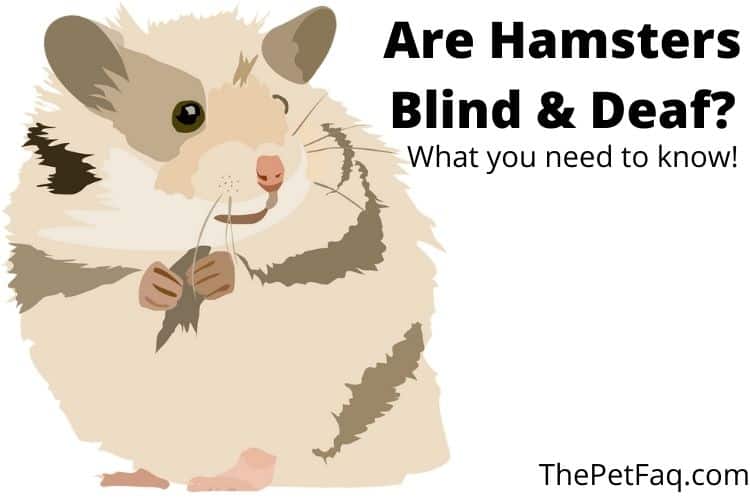The adorable appearance and easy-to-care-for nature of the hamster have made them beloved pets in millions of households. While most people know a thing or two about these little critters, there are a lot of questions about them. For instance, many people wonder if hamsters are deaf or blind, or perhaps even both? How do they really perceive the world?

To shed some light on this topic, we’re going to put your hamster’s eyesight and hearing under the microscope. Let’s get into it!
Are hamsters blind?

Hamsters are not blind, they are capable of seeing. It is true that baby hamsters are born blind, but they start opening their eyes and are able to see at around 3 weeks of age.
Nevertheless, while hamsters are not fully blind, it is true that their vision is quite poor, as they are nearsighted. This is the case for all hamsters, but especially for those with red eyes. As you might’ve noticed, the eyes of your hamster are on the side of its head. Many prey animals share a similar characteristic. The reason why they have eyes on the sides of their head, rather than on the front, is because it gives them a wider field of vision. This gives them a better chance to see predators that are trying to sneak up behind them and give them time to flee.
However, while their side-on eyes help them notice predators that are trying to sneak up on them, it also means that they have a much poorer vision of what’s happening in front of them. It happens quite often that hamsters don’t notice you if you stand right in front of them if you do not move. If you then suddenly move they even get scared sometimes! In addition, their eye placement means that they’re incapable of judging depths or heights. This sometimes results in hamsters trying to jump from places that are much too high for them.
If you’re curious about how your hamster sees the world, this video is quite interesting!
Are hamsters color blind?
While hamsters are not blind, they are colorblind! The reason why hamsters are color blind is that they have a lot of rod cells but not a lot of cone cells in their eyes. Cone cells are what’s responsible for making sure that you can see colors while rod cells are responsible for perceiving the size, shape, and brightness of visual images.
Nevertheless, while hamsters are considered colorblind, this does not mean that they see the world in black and white. They can see some colors. The colors they can see depend on the breed of hamster that you have. One study showed that Syrian hamsters see in the green range of the electromagnetic spectrum while Winter White hamsters see in the blue range.
Nevertheless, none of the hamster breeds see a whole lot of colors, thus they’re considered color blind.
Why hamsters have poor eyesight
The reason why hamsters have poor eyesight is quite simple: they’re nocturnal creatures. Nocturnal means that they spend the majority of their waking hours in the darkness of the night. Hamsters like the dark because it helps them hide from predators.
Since it’s dark at night, they do not benefit all that much from having good eyesight. Because of that, there was no evolutionary pressure to have strong eyesight. They benefited much more from having good hearing and scent, both of which are not affected by the darkness of the night. As a result, hamsters have weak eyesight but strong hearing and smell! This also explains why they are color blind. After all, there’s not much need to see colors when you’re primarily active in the night!
One interesting caveat is that while hamsters have poor vision, they’re decently capable of seeing in the low-light conditions of the night because of how many rod cells they have in their eyes.
Are hamsters deaf?
Hamsters are absolutely not deaf. While their eyesight is not good, their hearing is excellent. Hamsters are capable of hearing sounds that are inaudible to the human ear. They can hear frequencies between 96 Hz to 46.5 kHz.
Hamsters use their hearing extensively. In the wild, they use it to locate predators. In captivity, they do not have to worry about predators, but hamsters do not understand that. They’re smart animals, but not smart enough to understand that there’s a 0% chance of a buzzard suddenly descending through your roof and snatching them. Because of that, they keep their ears peeled at all times to ensure they hear anything that might be coming their way.
This is part of the reason why hamsters are sometimes nervous when they’re newly adopted into your home. They have to get used to all the sounds that surround them.
One sense that they rely on even more than hearing is scent. Olfactory cues are the hamster’s primary way of navigating the world.
Navigating the world through smell
You might think that having poor eyesight is debilitating for your hamster. After all, how can they possibly find their way around if they can barely see? It’s normal for humans to think like that because we’re so dependent on our sense of sight. As humans, we’d be almost completely lost without our keen sense of sight.
Hamsters? Not so much…
Hamsters have an amazing sense of smell. They can pick up on scents that we don’t even notice and are capable of tying these scents to individuals, memories, and locations. Because of this, their sense of smell is essential in helping them navigate the world.
Scent is also an essential component in their communication. Humans use a lot of non-verbal communication, hamsters do a similar thing, but with scents instead of visually. Every hamster has their own unique scent, which allows hamsters to recognize the scents of other individuals. Furthermore, it’s important during breeding. When a female hamster is in heat and ready to breed it releases a strong odor to attract males.
As you can understand, smell is very important to hamsters. They rely on it much more than sight to navigate the world.
Final words
Hamsters are not blind. They open their eyes and are able to see at about 3 weeks of age. Nevertheless, their vision is very poor. They’re colorblind and nearsighted. This gives them horrible depth perception and a general inability to see very well.
On the other hand, hamsters are definitely not deaf. They have excellent hearing abilities, being able to pick up on sounds that are inaudible to the human ear.
Hamsters have poor eyesight and good hearing and smell because they’re most active at night. Strong hearing and smell are not affected by a lack of light like the ability to see is, which is why these senses evolved to be much stronger.
- How Long Do American Eskimo Dogs Live? Important Factors and Care Tips - September 29, 2023
- Do American Bulldogs Need Grooming? Essential Tips and Care Guidelines - September 29, 2023
- Do Bengal Cats Enjoy Playing? Essential Tips for Keeping Them Active - September 29, 2023